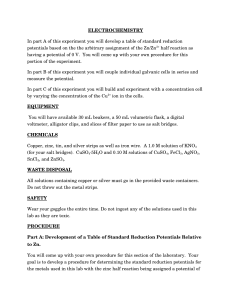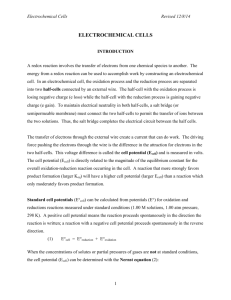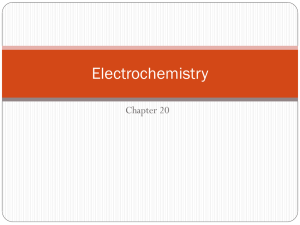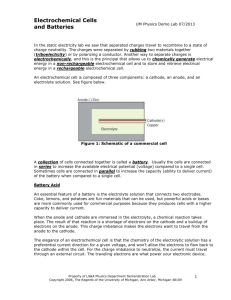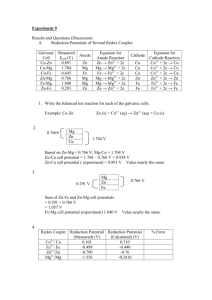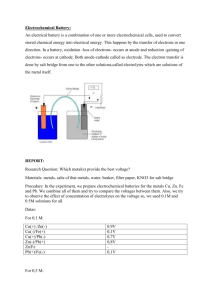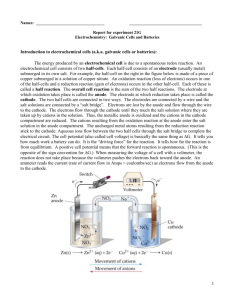Electrochemical Cells Lab: Experiment & Analysis
advertisement
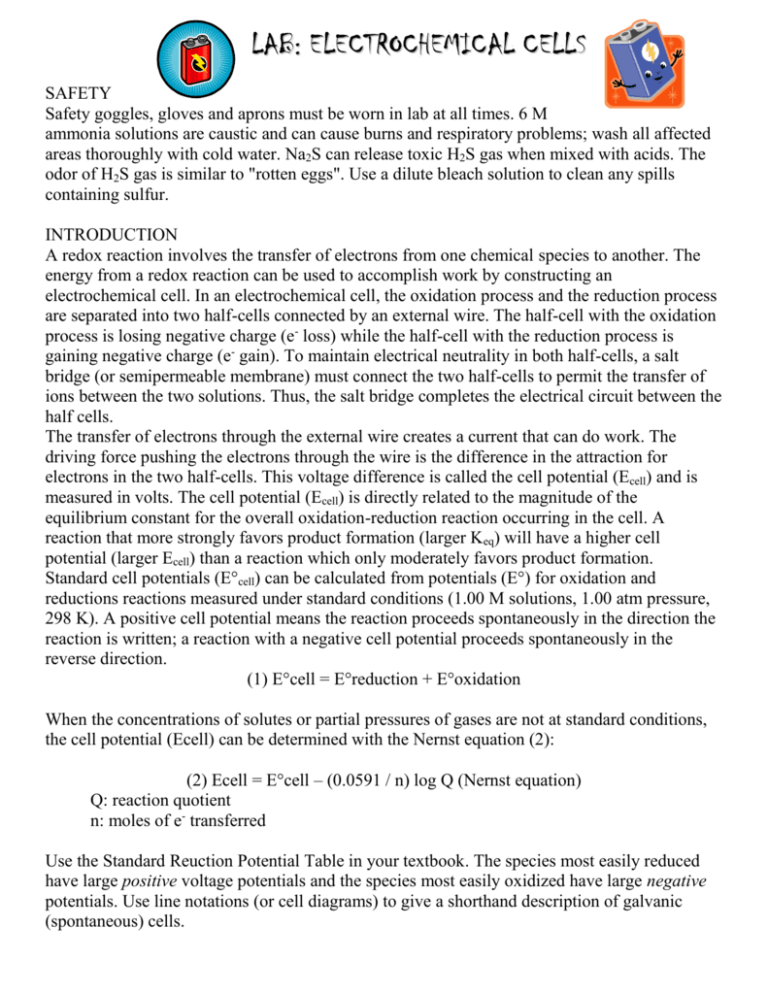
LAB: ELECTROCHEMICAL CELLS SAFETY Safety goggles, gloves and aprons must be worn in lab at all times. 6 M ammonia solutions are caustic and can cause burns and respiratory problems; wash all affected areas thoroughly with cold water. Na2S can release toxic H2S gas when mixed with acids. The odor of H2S gas is similar to "rotten eggs". Use a dilute bleach solution to clean any spills containing sulfur. INTRODUCTION A redox reaction involves the transfer of electrons from one chemical species to another. The energy from a redox reaction can be used to accomplish work by constructing an electrochemical cell. In an electrochemical cell, the oxidation process and the reduction process are separated into two half-cells connected by an external wire. The half-cell with the oxidation process is losing negative charge (e- loss) while the half-cell with the reduction process is gaining negative charge (e- gain). To maintain electrical neutrality in both half-cells, a salt bridge (or semipermeable membrane) must connect the two half-cells to permit the transfer of ions between the two solutions. Thus, the salt bridge completes the electrical circuit between the half cells. The transfer of electrons through the external wire creates a current that can do work. The driving force pushing the electrons through the wire is the difference in the attraction for electrons in the two half-cells. This voltage difference is called the cell potential (Ecell) and is measured in volts. The cell potential (Ecell) is directly related to the magnitude of the equilibrium constant for the overall oxidation-reduction reaction occurring in the cell. A reaction that more strongly favors product formation (larger Keq) will have a higher cell potential (larger Ecell) than a reaction which only moderately favors product formation. Standard cell potentials (E°cell) can be calculated from potentials (E°) for oxidation and reductions reactions measured under standard conditions (1.00 M solutions, 1.00 atm pressure, 298 K). A positive cell potential means the reaction proceeds spontaneously in the direction the reaction is written; a reaction with a negative cell potential proceeds spontaneously in the reverse direction. (1) E°cell = E°reduction + E°oxidation When the concentrations of solutes or partial pressures of gases are not at standard conditions, the cell potential (Ecell) can be determined with the Nernst equation (2): (2) Ecell = E°cell – (0.0591 / n) log Q (Nernst equation) Q: reaction quotient n: moles of e- transferred Use the Standard Reuction Potential Table in your textbook. The species most easily reduced have large positive voltage potentials and the species most easily oxidized have large negative potentials. Use line notations (or cell diagrams) to give a shorthand description of galvanic (spontaneous) cells. Example: A galvanic cell is constructed from solutions in two beakers connected by a salt bridge and an external wire. One beaker contains 0.15 M Cd(NO3)2 and a Cd metal electrode. The other beaker contains 0.20 M AgNO3 and Ag metal electrode. The net ionic equation for the cell reaction is: (3) 2 Ag+(aq) + Cd(s) → Cd2+(aq) + 2 Ag(s) Write the half reactions and identify oxidation and reduction reactions: Anode: Cathode: Write the line notation for this reaction: Solutions and metals: 0.1 M solutions: ZnSO4, CuSO4, MgSO4, and 0.05M Al2(SO4)3 and their metal electrodes (solid Zn, Cu, Al, and Mg). PROCEDURE: Part A: Create electrochemical cells 1. Obtain a spot plate and clean it before use. 2. Put about 25 drops of CuSO4 and a Cu electrode in one of the wells to create a Cu2+/Cu half cell. 3. Repeat the same procedure with the remaining solutions and electrodes, recording their location on the spot plate. Place the wells adjacent to each other, forming a square so they can easily be connected by a salt bridge. 4. To make a salt bridge, saturate small strips of filter paper with 1 M KCl solution. Select any two cells and connect them by the salt bridge (e.g. place one end of the salt bridge in the Cu cell and the other end in the Zn cell). 5. Determine the potential by touching the voltage probes to the electrodes in the cells. Do this by bringing the black lead of the probe in contact with one metal electrode and red lead in contact with the other electrode. If the voltage reads 0.00 V, then reverse the leads until you have a positive voltage. Wait about 5 seconds to take a voltage reading and record the value in your table. 6. Determine which cell was the anode and which was the cathode: If the measured voltage is positive, the cell connected to the black lead is the anode and the cell connected to the red lead is the cathode. Once you have recorded this information, measure the potentials for the remaining cells, making as many combinations of two cells possible with the solutions provided. Be sure to note the anode and cathode for each combination and use a new salt bridge for each set of cells. Part B: Measure the effect of concentration on a cell 1. Measure the voltage again for the Cu/Zn cell. Add 1 drop of 6 M NH3 solution to the Cu well (stir with toothpick) and record the voltage. 2. Place a piece of white paper under the spot plate to observe the color of the Cu(NH3)42+ complex ion that is formed. (This color test is one that is frequently used to determine the presence of copper (II) ion in a solution.) 3. Add one more drop of NH3 and measure the voltage again. (Did you see any voltage change?) Create a new Cu/Zn cell and repeat the procedure using 2 M Na2S solution instead of NH3. Record the voltage after each drop is added and observe the color of the CuS precipitate. DATA & ANALYSIS Include the following in your data and analysis sections 1. Summarize Part A with a data table containing the headings: Anode, Cathode, Overall Cell Reaction, and Cell Potential. For each of cell combination, write the anode half reaction, the cathode half-reaction, the overall reaction in cell notation (the concentration of all solutions is 0.1 M), and the potential in volts. 2. Create a Reduction Potential Table with the cells containing copper from Part A. Assume the reduction potential for Cu2+ + 2e– → Cu is 0.00 V and calculate the remaining reduction potentials relative to Cu2+ / Cu. List the reactions in order of decreasing reduction potential. 3. Using the Reduction Potential Table from (2), a) Arrange the ions (e.g. Cu2+, Zn2+ etc.) in order of decreasing ability to be reduced: __________________ > ______________ > etc. (most easily reduced) b) Arrange the metals (e.g. Cu, Zn etc.) in order of decreasing ability to be oxidized: __________________ > ______________ > etc. (most easily oxidized) 4. Qualitatively explain the effect of changing concentration of Cu2+ on voltage (Part B) using your experimental observations and the Keq values below. (No calculations are required.) a. Cu2+(aq) + 4 NH3(aq) → [Cu(NH3)4]2+(aq) Keq = 1.2 x 1012 b. CuS(s) � Cu2+(aq) + S2–(aq) Keq = 8.5 x 10–45 5. What is the color of the 0.1 M CuSO4 solution? What color changes are observed when ammonia and Na2S are added to the Cu2+ solution?
